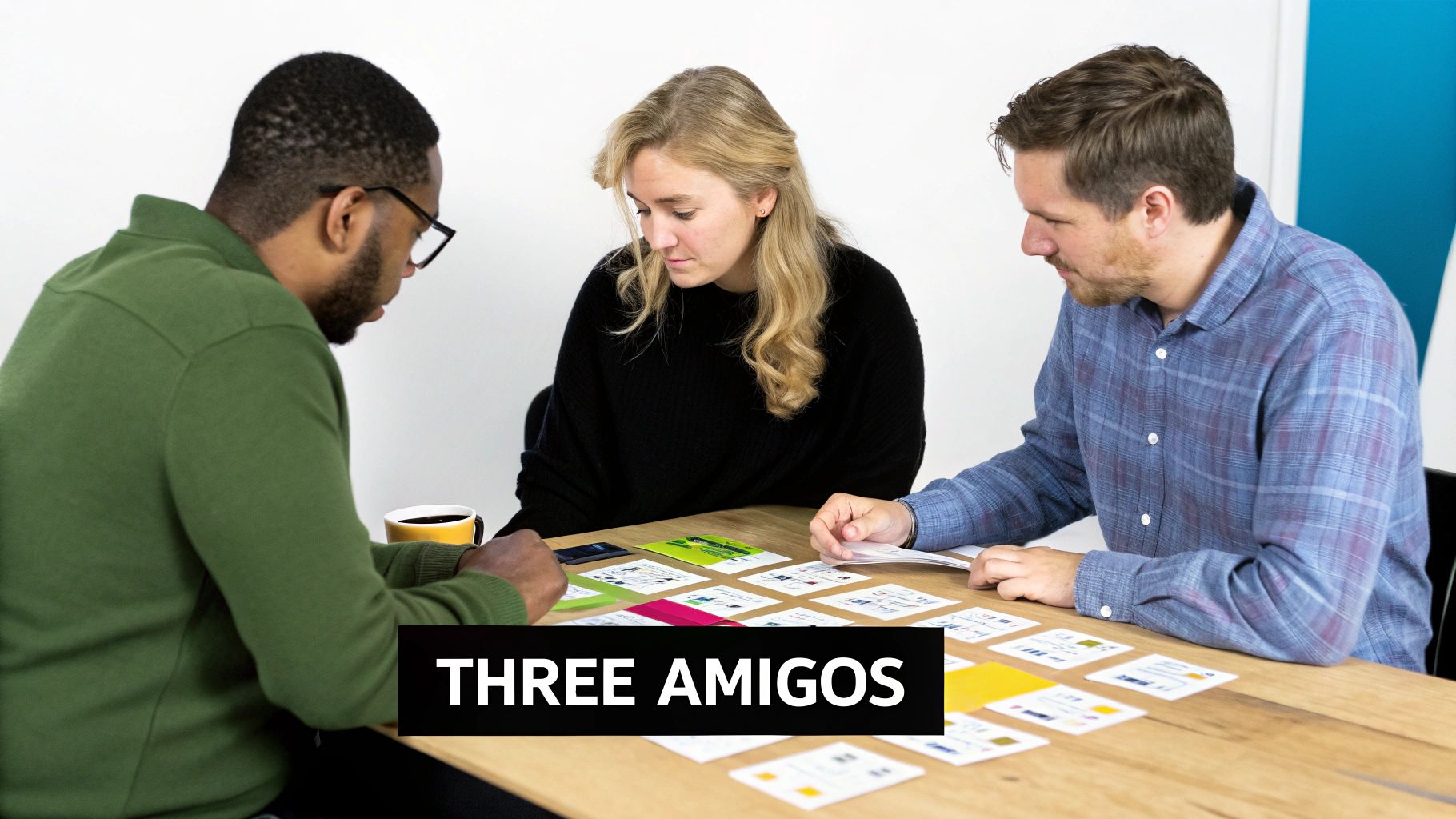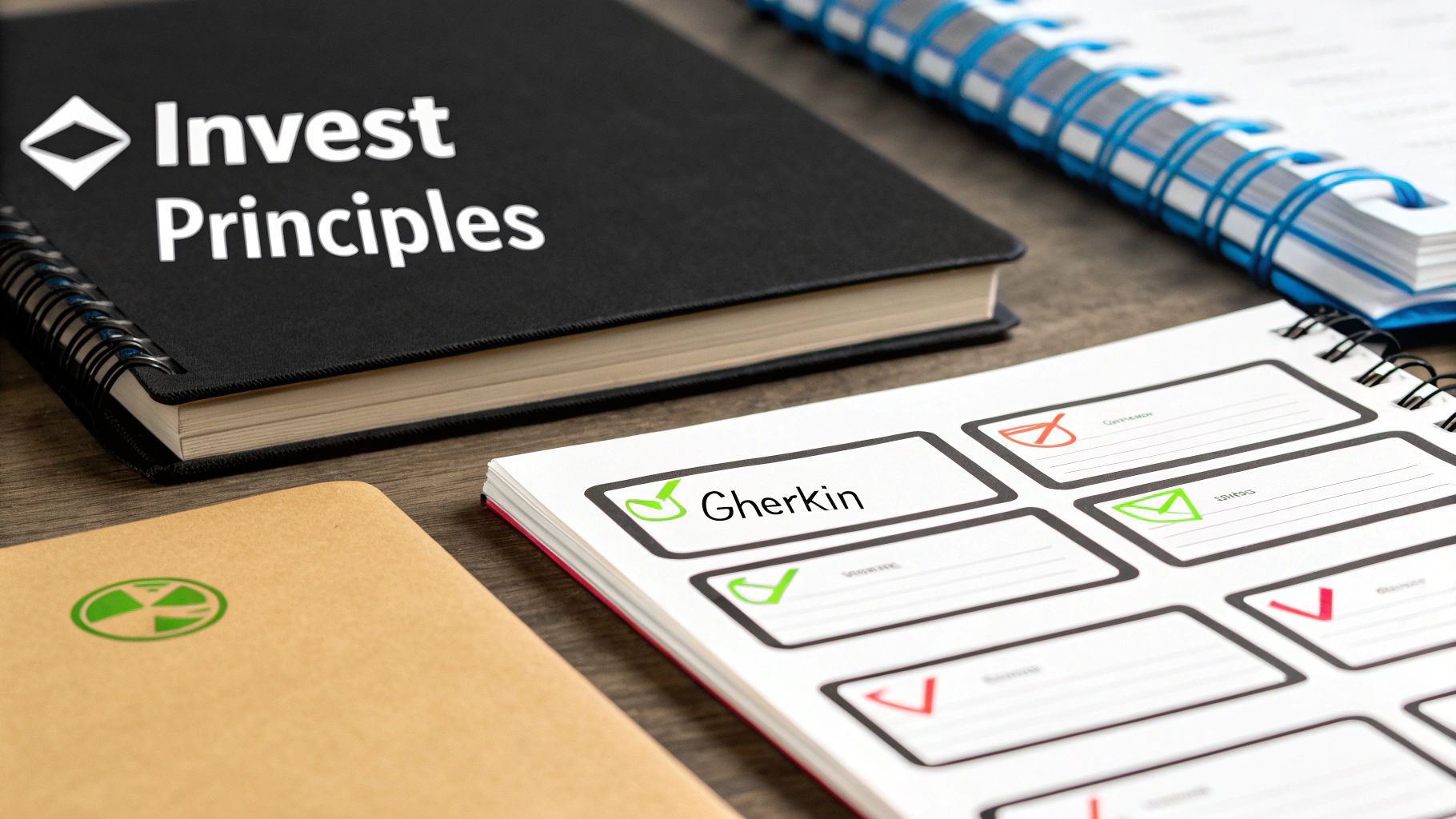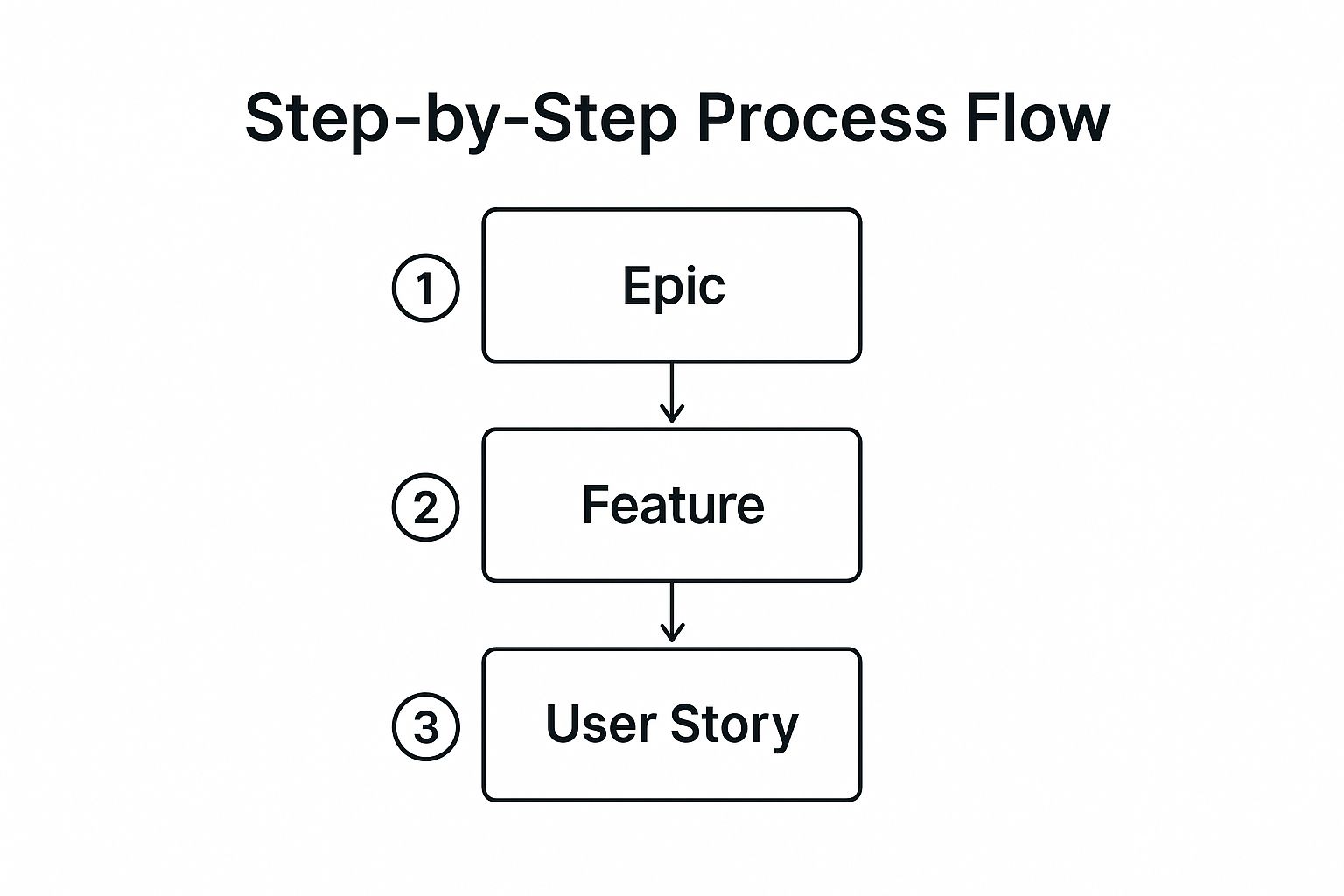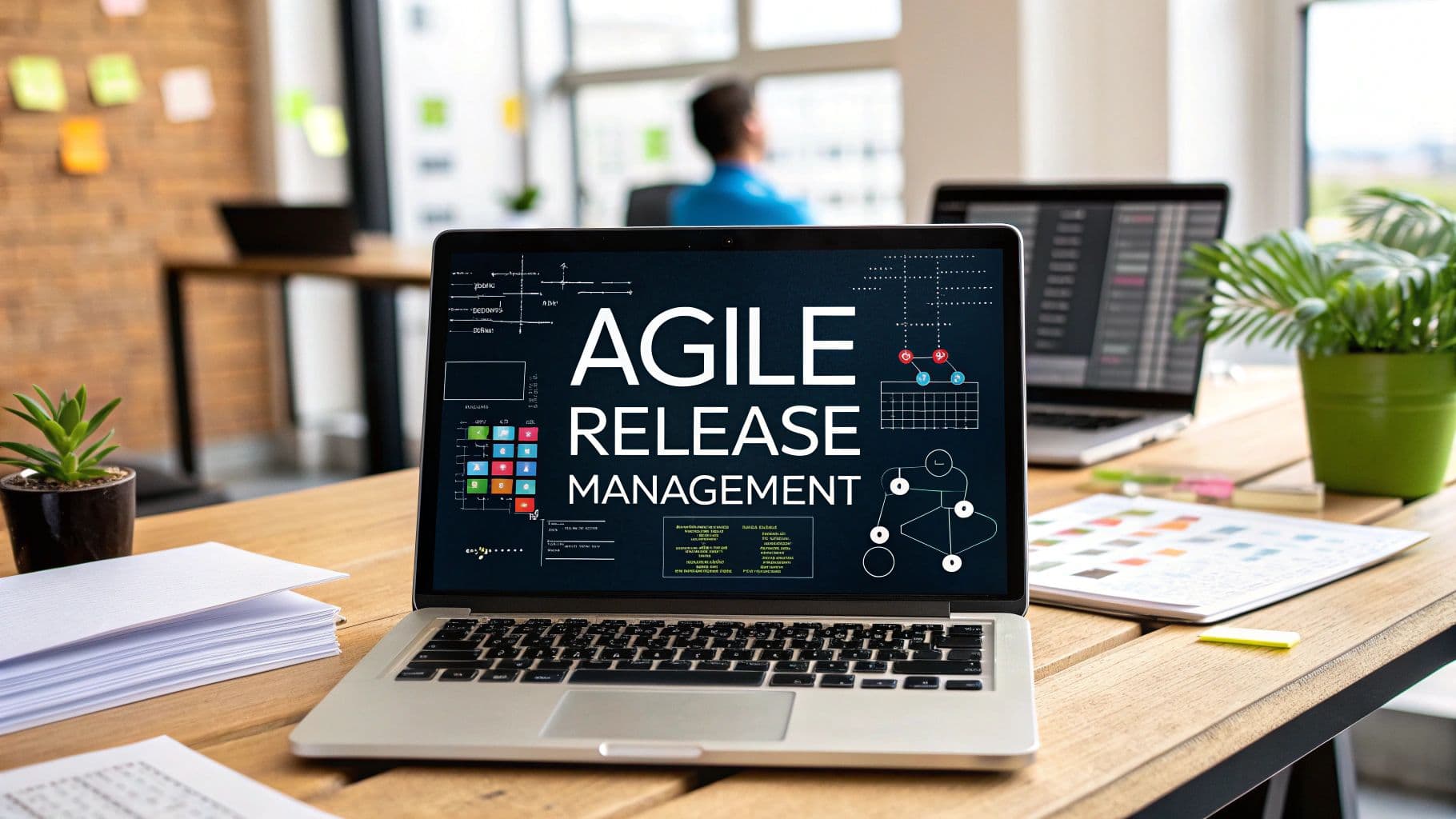backlog refinement best practices
agile development
scrum master tips
product backlog
sprint planning
7 Essential Backlog Refinement Best Practices for 2025
From Cluttered Backlog to Clear Roadmap: Why Refinement Matters
In Agile development, a well-managed product backlog is the engine of a high-performing team. Yet, many teams struggle with a backlog that is more of a black hole than a strategic roadmap, filled with vague user stories, missing details, and conflicting priorities. This chaos often leads to longer sprint planning meetings, wasted effort on rework, and features that ultimately miss the mark with users. Effective backlog refinement is the critical process that prevents this.
It's not just about grooming a list; it's a strategic activity of collaboration and clarification that transforms raw ideas into actionable, value-driven work. This guide cuts through the noise to deliver a definitive list of backlog refinement best practices. We will move beyond generic advice to provide actionable techniques you can implement immediately.
You will learn how to:
- Establish a consistent refinement cadence.
- Foster powerful collaboration with the "Three Amigos" approach.
- Implement a clear Definition of Ready (DoR) to ensure quality.
- Master story sizing and advanced estimation techniques.
By mastering these concepts, your team can build a predictable development rhythm, ensure stakeholder alignment, and consistently deliver products that matter.
1. Master the Rhythm with Regular Cadence and Timeboxing
The most foundational of all backlog refinement best practices is treating it not as an event, but as a continuous process. Ad-hoc refinement sessions, often squeezed in right before sprint planning, create a frantic scramble that results in poorly understood user stories and rushed estimates. Mastering a regular cadence with strict timeboxing transforms this chaos into a predictable and productive ritual.
This practice involves scheduling refinement sessions as a recurring, non-negotiable meeting in your team’s calendar. The key is consistency. By dedicating a specific, fixed time slot, you create a reliable rhythm. This removes the mental overhead of "when will we do refinement?" and ensures it always gets done.
Why It's a Foundational Practice
A consistent cadence creates a continuous flow of "ready" work. Instead of facing a massive, unrefined backlog during sprint planning, the team engages with a small, manageable batch of well-prepared stories. This prevents bottlenecks, reduces the length and stress of planning meetings, and allows the team to maintain focus on the current sprint's goals without being constantly derailed by future work.
This discipline also builds a forward-looking mindset within the team. The backlog stops being a daunting to-do list and becomes a strategic, well-organized roadmap. It ensures the product owner has enough lead time to gather requirements and the development team has ample opportunity to ask clarifying questions, investigate technical complexities, and provide more accurate estimates.
Actionable Steps for Implementation
To implement this effectively, follow these steps:
- Allocate Capacity: Formally dedicate 5-10% of your team's total capacity per sprint to refinement activities. This explicitly values the work and protects it from being pushed aside.
- Schedule Recurring Sessions: Book one or two fixed-length sessions each week (e.g., every Tuesday and Thursday from 10:00 to 11:00 AM). The duration should be timeboxed, typically between 60 to 90 minutes, to maintain high engagement and focus.
- Set a Clear Agenda: Each session must have a goal. The product owner should prepare a short list of 2-4 high-priority items to discuss. This prevents aimless wandering through the backlog.
- Protect the Timebox: Be ruthless about starting and ending on time. If you don't get through everything on the agenda, it's a signal to adjust for next time, not to extend the meeting. This discipline respects everyone's time and keeps the process efficient.
2. Embrace the Power of Three Amigos Collaboration
While a full-team refinement is valuable, the "Three Amigos" approach introduces a focused, high-impact preparatory step. This collaborative practice brings together three critical perspectives to analyze user stories: the Product Owner (representing the business 'what' and 'why'), the Developer (representing the technical 'how'), and the Tester/QA (representing the quality 'what if?'). This trio works together to ensure stories are well-understood, feasible, and testable before they are presented to the wider team.
This isn't about excluding the team; it's about doing the initial deep dive efficiently. The Three Amigos session acts as a pre-refinement check, clarifying ambiguities and defining acceptance criteria so that the subsequent full-team meeting is smoother and more productive. It's a core tenet of modern backlog refinement best practices, ensuring a shared understanding from the very start.

Why It's a Foundational Practice
The Three Amigos method systematically eliminates misunderstandings that often arise late in the development cycle. By ensuring business, development, and quality perspectives are aligned early, it dramatically reduces the risk of rework. Stories refined through this lens are less likely to have hidden complexities or ambiguous requirements, preventing costly mid-sprint surprises.
This practice, popularized by thought leaders like George Dinwiddie, creates a robust shared understanding. For instance, teams at Capital One use it for complex regulatory features to ensure compliance, business logic, and technical implementation are perfectly in sync. The discussion moves beyond just the "happy path" to actively explore edge cases, potential failure points, and non-functional requirements, resulting in stories that are truly "ready" for development.
Actionable Steps for Implementation
To integrate the Three Amigos into your workflow, follow these steps:
- Identify Your Amigos: For each story or feature, designate a specific Product representative, a Developer, and a QA/Tester. The individuals can change based on the expertise required for the work item.
- Focus the Scope: Keep these sessions short and highly focused. Limit each meeting to just 1-3 high-priority user stories to allow for a deep, meaningful conversation rather than a superficial overview.
- Prepare Scenarios: The Product Owner should come prepared with user goals, while the Developer and Tester should think about potential implementation challenges and edge cases respectively. Using collaborative tools like Miro can help visualize these scenarios.
- Document Outcomes: The primary output should be clearly defined acceptance criteria. Document all assumptions, decisions, and open questions directly on the work item so the entire team has full context later.
3. Establish a Clear Definition of Ready (DoR)
One of the most powerful backlog refinement best practices is to formalize a "Definition of Ready" (DoR). The DoR is a shared understanding, often in the form of a checklist, that a user story or backlog item must meet before it can be pulled into a sprint. It acts as a quality gate, preventing ambiguous, oversized, or poorly understood work from derailing the development team’s focus and flow.
By establishing these criteria, the team ensures that every item discussed in sprint planning is genuinely "ready" for development. This practice, popularized by thought leaders like Roman Pichler and Mike Cohn, eliminates the common problem of starting a sprint with stories that still have major unanswered questions, missing dependencies, or lack clear acceptance criteria.
Why It's a Foundational Practice
A well-defined DoR is the ultimate safeguard against sprint commitment anti-patterns. It transforms refinement from a simple discussion into a validation process. When an item meets the DoR, the team has high confidence that it is well-understood, valuable, and feasible to complete within a sprint. This significantly reduces in-sprint uncertainty and scope creep.
This practice forces critical conversations to happen before the commitment, not during the build. It empowers the development team to push back on unprepared work, creating a healthy feedback loop that encourages the product owner to bring well-vetted items to the table. For example, Netflix engineering teams often use a DoR that includes confirmation of user research validation and completion of any necessary technical spikes, ensuring work is both customer-centric and technically sound before a single line of code is written.
Actionable Steps for Implementation
To implement a DoR without creating unnecessary bureaucracy, follow these steps:
- Start Small and Evolve: Begin with 5-7 core criteria. A good starting point includes: User Story is clear (INVEST criteria), Acceptance Criteria are defined, Dependencies are identified, and an initial Estimate is present.
- Make It Visible: Document your DoR and display it prominently on your physical or digital team board (e.g., Jira, Trello). This constant visibility reinforces its importance and makes it an active part of your workflow.
- Include Non-Functional Requirements (NFRs): Ensure your checklist prompts consideration of NFRs like performance, security, and accessibility. This prevents them from becoming afterthoughts. To ensure that all items, including bug fixes, meet a high standard for clarity and completeness before being worked on, your Definition of Ready should incorporate insights from these essential bug reporting best practices.
- Review and Adapt Quarterly: Your DoR is not set in stone. Hold a review every quarter to ask: "What criteria are causing bottlenecks? What's missing that led to problems last sprint?" Adapt it based on team retrospectives and evolving needs.
4. Story Sizing and Estimation Techniques
A core component of effective backlog refinement best practices is moving from abstract ideas to tangible work units. Story sizing and estimation techniques provide a systematic way to gauge the effort, complexity, and uncertainty of user stories. Instead of guessing, teams use collaborative methods like Planning Poker or T-shirt sizing to assign a relative value, making sprint planning more predictable and scope discussions more concrete.
This practice is not about promising exact timelines but about creating a shared understanding of what a story entails. It forces the team to dissect the work, ask critical questions, and uncover hidden complexities or dependencies early on. When a story is difficult to estimate, it's often a signal that it's not well understood and needs more refinement before being considered "ready" for a sprint.
Why It's a Foundational Practice
Systematic estimation fosters alignment and transparency. When the entire development team participates in sizing, it pools collective knowledge, leading to more realistic and reliable figures. This process illuminates potential risks and helps the product owner understand the "cost" of a feature, which is crucial for prioritization. For instance, knowing one feature is a "small" (3 points) while another is an "extra-large" (13 points) directly influences strategic decisions.
Furthermore, this practice improves a team's ability to forecast. By tracking story points completed per sprint (velocity), teams can make data-driven projections about how much work they can realistically take on. This transforms sprint planning from a wish-list exercise into a predictable commitment, reducing team burnout and increasing stakeholder confidence. The goal is not perfect accuracy but a consistent, relative understanding of effort.
Actionable Steps for Implementation
To implement this effectively, follow these steps:
- Choose Your Technique: Select a method that fits your team's maturity and context. Planning Poker with the Fibonacci sequence (1, 2, 3, 5, 8, 13) is excellent for detailed story-level estimation. T-shirt sizing (XS, S, M, L, XL) is better for quick, high-level estimates on epics or new initiatives.
- Establish a Baseline: Identify a simple, well-understood "reference story" and assign it a specific value (e.g., 2 story points). All future estimations will be relative to this baseline. This calibration is key to maintaining consistency.
- Focus on Relative Sizing: Emphasize that story points represent a mix of effort, complexity, and uncertainty, not hours or days. The discussion should center on "Is this story bigger or smaller than our reference story?" rather than "How long will this take?"
- Break Down Large Stories: If a story receives a high estimate (e.g., 13 or higher in Planning Poker), it's a clear signal to break it down into smaller, more manageable pieces. This rule helps keep work items focused and deliverable within a single sprint.
5. Acceptance Criteria Definition and INVEST Principles
A user story is only as good as its acceptance criteria. This practice centers on collaboratively defining clear, testable conditions of satisfaction for every story while ensuring it adheres to the INVEST principles. This dual approach transforms ambiguous requests into well-defined, deliverable, and valuable pieces of work with unambiguous success criteria for development and testing teams.

The INVEST acronym, coined by Bill Wake, serves as a checklist for story quality: Independent, Negotiable, Valuable, Estimable, Small, and Testable. When combined with explicit acceptance criteria, it ensures stories are not just "ready" but are genuinely prepared for successful implementation. For instance, Uber engineering teams embed this by specifying API contract requirements and error handling scenarios directly within story criteria.
Why It's a Foundational Practice
This practice is foundational because it directly prevents the "it works, but not like I expected" problem. Well-defined acceptance criteria create a shared understanding between the product owner, developers, and QA, leaving no room for assumptions. It serves as the definitive contract for what "done" means for a specific piece of functionality.
Adhering to INVEST principles ensures stories are properly sized and structured for an Agile workflow. This discipline prevents monolithic, dependent epics from being pulled into a sprint, which often leads to carry-over work and failed sprint goals. It forces the team to break down complexity early, making estimation more accurate and the development process smoother. This is a core tenet of effective backlog refinement best practices.
Actionable Steps for Implementation
To integrate this effectively into your refinement process, follow these steps:
- Embrace Gherkin Syntax: Use the Given-When-Then format to write acceptance criteria. This behavior-driven style is easy for both technical and non-technical stakeholders to understand (e.g., "Given I am a logged-in user, When I click the 'Add to Cart' button, Then the item appears in my shopping cart").
- Conduct an INVEST Check: During refinement, explicitly review each story against the INVEST checklist. Ask questions like: "Can this be built and tested independently?" or "Is this small enough to complete in a few days?". If a story fails, it needs more refinement.
- Define Both Positive and Negative Paths: Good criteria cover more than just the "happy path." Specify what should happen in error states or with invalid inputs (e.g., "Given the user enters an invalid password, When they click 'Login', Then an error message 'Invalid credentials' is displayed").
- Focus on 'What', Not 'How': Acceptance criteria should describe the required outcome and behavior, not the technical implementation. This gives the development team the autonomy to find the best solution. For example, Shopify product teams often include performance benchmarks (the 'what') without dictating the specific code changes (the 'how').
6. Progressive Story Decomposition
Trying to define every detail of a large feature or epic months before it's developed is a recipe for wasted effort and rework. Progressive story decomposition offers a smarter, just-in-time approach. This practice involves systematically breaking down large work items through multiple refinement passes, adding detail and precision only as the item moves closer to implementation. It's the art of starting broad and getting granular at the last responsible moment.
This method treats requirements elaboration not as a one-time event but as a continuous, multi-stage process. An epic might initially be a high-level concept. In one refinement session, it's broken into features. Later, as a feature rises in priority, it's decomposed into smaller, implementable user stories. This aligns perfectly with agile principles, ensuring the team's effort is always focused on the most valuable, near-term work.
Why It's a Foundational Practice
Progressive decomposition minimizes upfront analysis paralysis and maximizes adaptability. By deferring detailed planning, teams avoid speculating on requirements that may change. This "just-in-time" detailing ensures that the user stories developers pick up are based on the most current understanding of user needs and technical constraints. It makes the entire process more efficient and responsive.
This practice, central to effective backlog refinement best practices, directly improves the quality of user stories. Stories that have undergone multiple passes of decomposition are inherently better understood, more accurately estimated, and easier to test. It also empowers the team, as insights from early implementation can inform how later parts of the same epic are split and defined, a feedback loop that monolithic, upfront design simply cannot offer.
To illustrate this top-down approach, the following infographic shows the typical flow from a large-scale initiative to a manageable user story.

This visualization highlights how work is systematically broken down, ensuring that each stage provides the necessary context for the next level of detail.
Actionable Steps for Implementation
To implement this effectively, follow these steps:
- Start with Story Mapping: Use a user story map, a technique popularized by Jeff Patton, to visualize the entire user journey. This provides the high-level context needed to identify large epics and the features within them.
- Apply Vertical Slicing: When you decompose features into stories, slice them vertically. This means each story should deliver a small, tangible piece of end-to-end user value, rather than being split by technical layers (e.g., "build the database," "create the API").
- Use Multiple Refinement Passes: Don't try to decompose an epic into perfect user stories in one session. Use the first pass to break it into features. In subsequent sessions, take the highest priority feature and break it into stories.
- Maintain Traceability: Use your backlog management tool to link user stories back to their parent features and epics. This traceability is crucial for understanding context, tracking progress, and communicating with stakeholders.
7. Build a Bridge with Stakeholder Engagement and Feedback Loops
Refinement conducted in a vacuum is one of the quickest ways to build a product that misses the mark. Truly effective backlog refinement best practices extend beyond the development team and product owner, systematically involving key stakeholders. This practice is about creating intentional, structured feedback loops with users, domain experts, and business leaders to ensure user stories accurately reflect real-world needs and strategic objectives.
By directly engaging stakeholders, you move from making assumptions to validating them. For instance, a healthcare software team might involve medical billing experts to refine a new claims processing feature, ensuring it aligns with complex industry regulations. Similarly, a fintech company could bring in compliance officers to review stories related to anti-money laundering (AML) protocols. This proactive collaboration turns refinement into a powerful alignment tool, preventing costly rework and ensuring development effort is laser-focused on delivering genuine business value.
Why It's a Foundational Practice
Engaging stakeholders early and often de-risks development. It closes the gap between the business's vision and the technical team's execution. This direct line of communication uncovers critical nuances, edge cases, and hidden requirements that would otherwise only surface late in the development cycle or, worse, after launch. It transforms the backlog from a list of technical tasks into a shared record of business agreements.
This practice also fosters a culture of shared ownership and transparency. When stakeholders see their input directly influencing the product's direction, they become more invested partners. It builds trust and ensures that when the team delivers a feature, it's not just technically sound, it's also precisely what the business needed. The goal is to make "that's not what I asked for" a phrase of the past.
Actionable Steps for Implementation
To build effective feedback loops, follow these steps:
- Create a Stakeholder Matrix: Identify key stakeholders for different product areas or feature types. Map out who needs to be consulted, who just needs to be informed, and how frequently. Not every stakeholder needs to be in every session.
- Establish Structured Feedback Channels: Don't rely on ad-hoc emails or hallway conversations. Use structured methods like feedback templates, dedicated Slack channels, or formal review sessions to gather consistent, actionable input. For more on this, you can learn more about how to collect customer feedback.
- Prepare Stakeholders for Success: Before a session, provide context. Share the user story, the problem it solves, and the specific questions you have. This respects their time and enables them to provide much more targeted and valuable feedback.
- Document Decisions and Rationale: During and after stakeholder interactions, meticulously record the decisions made and, more importantly, the "why" behind them. This historical context is invaluable for future reference and for onboarding new team members.
Backlog Refinement Best Practices Comparison
| Item | Implementation Complexity 🔄 | Resource Requirements 🔄 | Expected Outcomes 📊 | Ideal Use Cases 💡 | Key Advantages ⭐⚡ |
|---|---|---|---|---|---|
| Regular Cadence and Timeboxing | Medium - requires scheduling discipline and preparation | Moderate - 10-15% team capacity for sessions | Continuous flow of ready stories, reduced sprint planning time | Teams needing predictable and structured backlog grooming | Ensures rhythm and focus, prevents last-minute rush ⭐, maintains engagement ⚡ |
| Three Amigos Collaboration | High - coordination of multiple roles and facilitation needed | High - involvement of Product Owner, Developer, Tester simultaneously | Improved story quality, reduced misunderstandings, early risk detection | Complex stories requiring cross-discipline alignment | Shared understanding, early testability, reduces rework ⭐ |
| Definition of Ready (DoR) | Low to Medium - requires initial checklist creation and maintenance | Low - team agreement and regular review required | Consistent quality standards, fewer poorly defined stories | Teams aiming to improve sprint commitment accuracy and quality | Prevents unclear stories entering sprints, improves confidence ⭐ |
| Story Sizing and Estimation | Medium - needs consensus building and calibration | Moderate - team participation and historical data | Accurate sprint planning and predictable delivery | Teams needing reliable effort estimation methods | Promotes shared understanding, highlights complexity differences ⭐ |
| Acceptance Criteria & INVEST | Medium - skill needed for clear, testable criteria writing | Moderate - time investment per story and skill development | Clear story scope and testability, reduces ambiguity | Projects emphasizing quality and test-driven development | Enables automated testing, better communication, clearer scope ⭐ |
| Progressive Story Decomposition | Medium to High - requires ongoing product ownership and coordination | Moderate to High - multiple refinement passes and mapping sessions | Flexible backlog, reduced waste, focus on near-term work | Large epics/features requiring staged breakdown | Avoids over-analysis, maintains flexibility, enables faster feedback ⭐ |
| Stakeholder Engagement & Feedback | High - manages multiple stakeholder schedules and inputs | High - stakeholder involvement, user research | Stories aligned with real user needs, reduced rework | Products with complex domains, regulatory or user-driven requirements | Leverages domain expertise, builds confidence, shared ownership ⭐ |
Turning Best Practices into Sustainable Habits
Mastering backlog refinement is not a one-time event; it is a continuous journey toward greater clarity, efficiency, and team alignment. The seven backlog refinement best practices detailed in this guide, from establishing a regular cadence to fostering deep stakeholder engagement, are not a rigid set of rules. Instead, view them as a powerful toolkit designed to help your team transition from a reactive, chaotic workflow to a proactive, value-driven development cycle.
The true power of these practices emerges when they become ingrained habits. Consistently applying techniques like the Three Amigos collaboration ensures that user stories are understood from multiple perspectives, drastically reducing ambiguity. Likewise, a well-defined Definition of Ready (DoR) acts as a quality gate, preventing half-baked items from derailing a sprint and protecting your team’s focus and morale. The goal is to create a system where high-quality, well-understood work flows predictably into your development pipeline.
From Theory to Actionable Improvement
Adopting these methods can feel daunting, so start small. Identify the most significant bottleneck in your current process. Is it unclear requirements? Introduce the INVEST principles for your next three user stories. Are meetings unproductive? Implement strict timeboxing and a clear agenda. The key is incremental, sustainable change.
Here are some actionable next steps to begin your journey:
- Assess Your Current State: Hold a brief team retrospective focused solely on your current backlog refinement process. What’s working? What isn’t?
- Pick One Practice: Based on your assessment, choose just one or two practices to implement. For example, focus on progressive decomposition for a large feature or formalize your acceptance criteria.
- Measure and Adapt: After a few sprints, review the impact. Has communication improved? Are estimations more accurate? Use this feedback to refine your approach or introduce another practice.
The Long-Term Impact of a Refined Backlog
A well-maintained backlog is more than just an organized to-do list; it is the strategic heartbeat of your product. It provides a clear, shared vision that aligns developers, product owners, and stakeholders, ensuring everyone is pulling in the same direction. This alignment minimizes wasted effort, reduces costly rework, and accelerates your ability to deliver tangible value to your customers. Investing in these skills elevates your team's capabilities and fosters a culture of excellence and predictability.
To embed these best practices and ensure your team continuously improves, consider exploring dedicated team training programs that can provide structured guidance and hands-on coaching to accelerate your adoption of these powerful Agile techniques.
Ultimately, by transforming these backlog refinement best practices into sustainable habits, you empower your team to build better products faster, with greater confidence and less friction.
Ready to streamline your development process even further? Many of these best practices, especially those involving stakeholder feedback and iterative development, benefit from rapid prototyping. AnotherWrapper allows you to build and deploy functional AI-powered web app prototypes in minutes, not weeks. Use it to quickly validate ideas from your backlog and gather concrete user feedback before writing a single line of production code. Try AnotherWrapper today and turn your refined backlog items into testable realities.
Fekri




